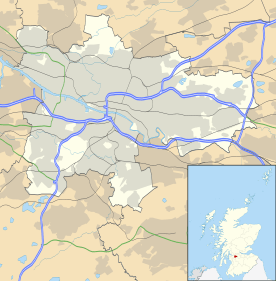Blythswood Hill
| Blythswood Hill | |
|---|---|
 Blythswood Hill Blythswood Hill shown within Glasgow | |
| OS grid reference | NS583656 |
| Council area | |
| Lieutenancy area |
|
| Country | Scotland |
| Sovereign state | United Kingdom |
| Post town | GLASGOW |
| Postcode district | G2 |
| Dialling code | 0141 |
| Police | Scottish |
| Fire | Scottish |
| Ambulance | Scottish |
| EU Parliament | Scotland |
| UK Parliament | |
| Scottish Parliament | |
Blythswood Hill is one of the drumlins overlooking the River Clyde, forming the city of Glasgow, Scotland, and was developed as one of its prestigious residential areas from 1800 onwards.[1]
It lies on the western flank of the city centre and as the name suggests rises to a plateau before dipping again towards the west end area of Park Circus and of Woodlands.To its north is Garnet Hill. The estate of Blythswood centres upon the area from Sauchiehall Street and Bath Street southwards to Bothwell Street, and below, and from West Nile Street westward to Elmbank Street and beyond.[2] The first street to be opened up was Bath Street in 1800, by William Harley who formed his pioneering public baths, dairy and bakery at its eastern end.[3] After the Reformation the Lands of Blythswood were owned by Sir George Elphinstone and changed to the Douglas-Campbell family during the 17th century. Archibald Campbell, whose son became Lord Blythswood set about feuing the lands to developers.[4]
Blythswood was developed as a result of the westward expansion of the city in the late 18th and early 19th centuries. Likened to Edinburgh's New Town, it housed the city's wealthy merchants and shipping magnates in Georgian townhouses. The area is on a grid-iron street plan which started first around George Square in the 1780s and was adopted by Glasgow Town Council for urban developments westwards, and south of the Clyde. The grid-iron system was later adopted by New York and other cities in America.[5]
Blythswood Square was the home of Madeleine Smith, a young woman - a daughter of leading architect James Smith - who in 1857 was tried for the murder by arsenic poisoning of her lover Pierre Emile L'Angelier. Although the verdict was not proven the story scandalised Scottish society, and is recounted in Jack House's 1961 book Square Mile of Murder.
Today, residential use is returning to Blythswood Hill, while it is mainly offices and forming, along with neighbouring Anderston, Glasgow's financial and commercial district. The conversion of the former Royal Scottish Automobile Club building by the Town House Company Ltd (8-13 Blythswood Square) to form the 5 Star Blythswood Square Hotel is considered to be a catalyst to the enhancement and improvement of the whole Blythswood Square.This project was successfully Project Managed by Philip H Thomson who have been responsible for other notable projects (ABC Complex, Hallion Club) in recent years.
Notable buildings
- Blythswood Square Category A listed terraces on each of its four sides (c.1823 – 1829) by John Brash for the trustees and successors of William Harley [6]
- Blythswood Square Hotel (2009) conversion of former RSAC.
- St. Vincent Street Church (1858–1859) by Alexander "Greek" Thomson, St Vincent Street. One of Glasgow's greatest buildings and possibly its most important ecclesiastical building after the Cathedral.
- St. Stephen's Renfield Church (1849–1852) by John Thomas Emmett, Bath Street
- Elgin Place Congregational Church (1865) by J.J. Burnet, corner of Bath Street and Pitt Street (demolished 2005)
- King's Theatre (1904) for Howard & Wyndham Ltd by Frank Matcham, Bath Street
- Glasgow Art Club 185 Bath Street, with gallery added by John Keppie and Charles Rennie Mackintosh [7]
References
- ↑ Architecture of Glasgow by Andor Gomme and David Walker, published in 1968 and 1987
- ↑ Buildings of Glasgow by Elizabeth Williamson, Anne Riches and Malcolm Higgs, published in 1990
- ↑ William Harley:A Citizen of Glasgow, by J Galloway, published in 1901
- ↑ Glasgow Past and Present, by Senex and others, three volumes published in 1884
- ↑ Glasgow Past and Present, by Senex and others, three volumes published in 1884
- ↑ http://www.scottisharchitects.org.uk/
- ↑ http://glasgowartclub.co.uk/